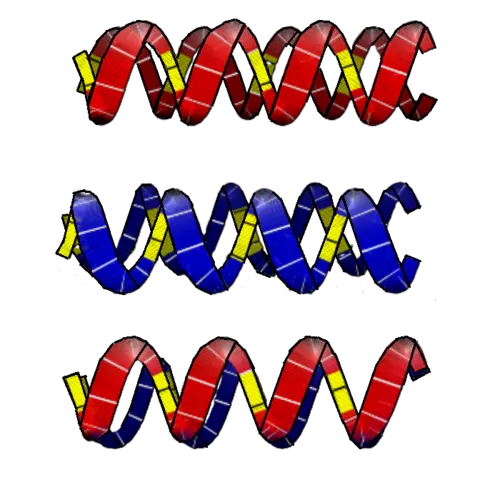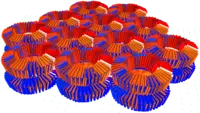A Physics Model
From First Principles
That Includes Gravity
From First Principles
That Includes Gravity
This is a physics model that begins with a mechanism for gravity, and then continues by building the model around that mechanism
The model contains suggestions for gravity, mass, electric charge, electric fields, and how to model the atom with particles
The reason for starting with gravity, is that there might be only a few mechanisms that can produce gravity*
If that is the case, then there is a chance that the model's chosen mechanism for gravity, could perhaps be the actual mechanism
Chirality is when an object has a left-handed form that is spatially different to its right-handed form
Such as our left and right hands

By custom, we shake hands with our right hands

Although the handshake would work just as well, if we were to use our left hands

However, a handshake where one person uses their left hand and the other uses their right hand
Is not the same kind of handshake
If the mechanism of electric charge were to be chiral in nature
Then the above suggests that the electric charge attractive force might not equal the electric charge repulsive force
A group of chiral electrical particles that are overall electrically neutral
Might have an overall attraction towards each other
Or might have an overall repulsion away from each other
Another example of chirality is the helix

A left-handed helix
Is spatially different to a right-handed helix
The following animation shows how left-handed and right-handed helix structures, have a slightly better contact, than the contact of left-handed and left-handed helix structures, and the contact of right-handed and right-handed helix structures, the button shows the small difference between the interactions, when the helix structures are tightly wound, the button start / stops the animation (any of the buttons can be used in pause mode)
Gravity
In the model, all the particles have an underlying helix structure - they are all chiral particles
It is the chiral nature of the particles, that gives rise to gravity in the model
Link to the model's detailed discussion on gravity
The model's four base particles are constructed using the model's elementary particle
A strand shaped particle that moves continuously at a single constant speed, through three dimensional space
The model's four base particles are
The neutrino, electron, positron, 'neutral' particle
The following animation shows a simple sequence of the elementary strand shaped particle, tagged one behind the other, building the model's four base particles - the neutrino, electron, positron, 'neutral' particle; the button steps through the process, the button start / stops the animation (any of the buttons can be used in pause mode)
Building The Four Base Particles
Instead of constructing the proton as two up quarks and one down quark, the proton is constructed as a positron sandwiched between two 'neutral' particles
And the neutron is constructed as a proton with an electron embedded into the side of the proton
This construction gives the proton an electric charge that is equal but opposite to the electron's electric charge
And gives the neutron equal amounts of positive and negative electric charge
The following animation shows the shapes and structures of the model's subatomic particles, the button steps through the particles, the button start / stops the animation (any of the buttons can be used in pause mode)
The Subatomic Particles
One way to explain how something works
Is to use words and pictures
Words and three dimensional pictures are used to explain how the model works
For example, how an electric field in the model makes an electron move
The following animation shows the model's electron, positron, 'neutral' particle, neutrino and particle of light, interacting with the short and long electric field particles, the button steps through the interactions, the 01 input box lists the interactions for direct selection, the button start / stops the animation (any of the buttons can be used in pause mode)
Electric Fields
Particles are used to model the atom
The same particles are used to model the double-slit experiment, the variation in the reflection of light, and the Stern-Gerlach experiment
In the model, atomic nuclei are built by using the electron that is embedded in the side of the neutron
To also embed into the side of a proton, joining the proton and neutron together
In the model, atomic nuclei have a flat structure

The protons and neutrons in the atomic nuclei, are held together by the 'neutral' particles in the protons and neutrons
Touching with the same edge spin
Using words and three dimensional pictures to model atomic nuclei
The following is an interactive animation, that lets you build the atomic nuclei, from hydrogen through to iron in the model, the button steps through prepared atomic nuclei configurations, the Element Filter input box lists the prepared atomic nuclei configurations for direct selection, the button start / stops the animation (any of the buttons can be used in pause mode)
Atomic Nuclei Builder
The following animation shows protons and neutrons, in the model, bonding together to form the atomic nuclei of hydrogen through to carbon, with decay sequences included for the unstable isotopes, the button start / stops the animation (any of the buttons can be used in pause mode)
Atomic Nuclei
Please bear in mind that later discussions may use details from earlier discussions
If you would like to help publicise the model for discussion, please feel free to inform other people about the model
Thank you
Bob Pike
(string for seach engines "aphysicsmodel" "thesimplemodel" "thesimpleuniverse")
A Physics Model The Simple Model The Simple Universe